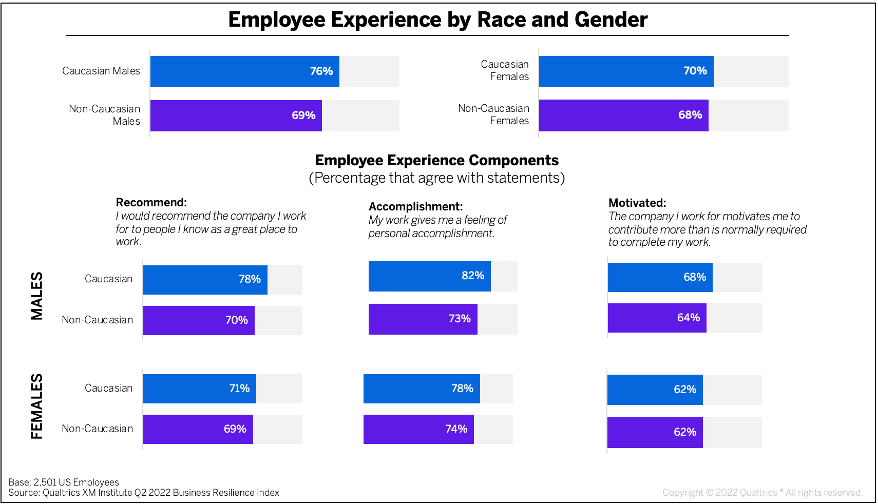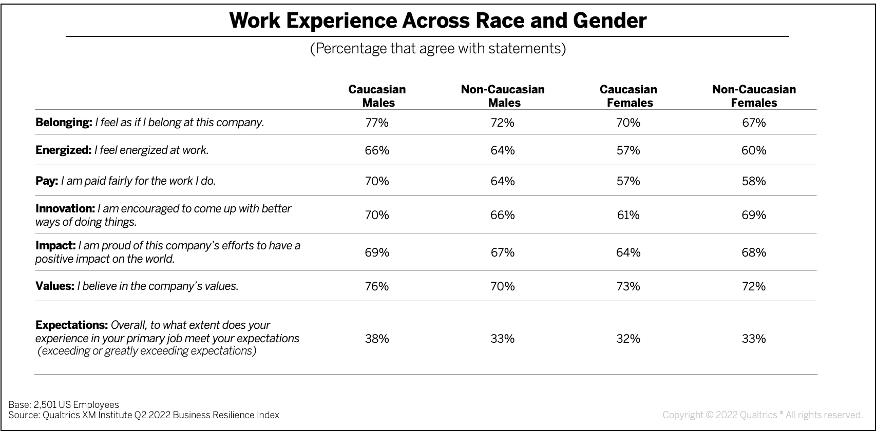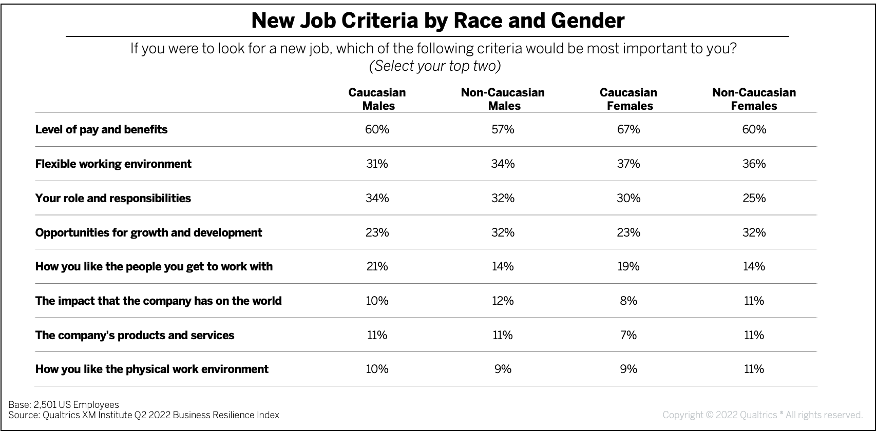XM Institute recently published the Business Resilience Index (BRI), which tracks the human-side of businesses by examining how people feel about the U.S. companies they interact with, as prospects, customers, and employees. One of the elements of the BRI is a measure of employee experience (EX), so we decided to dig a bit deeper into the EX score and examine the difference between race and gender.
In this analysis, we created two race categories, consisting of caucasians and non-caucasians (the latter category includes respondents who selected African-American, American Indian/Alaska Native, Asian or Pacific Islander, or “other”) and then intersected the results with the binary gender identifiers of male and female. While we recognize that each of the non-caucasian race groups is unique, we did not have enough self-identified data to analyze them separately and wanted to highlight gaps in employee experience between minoritized and majority groups.
As you can see in the graphic below:
- Caucasian men gave the highest overall EX ratings. The EX rating for caucasian men is 76%, which is by far the highest of the four groups, and the most positive across all three of the underlying EX components. Caucasian women are next on the list at 70%, followed closely by non-caucasian men at 69% and non-caucasian women at 68%.
- Caucasian men are the most likely to recommend their employer. When it comes to recommending their place of employment as a great place to work, caucasian men are 8 %-points higher than any other group, the largest gap across the component scores.
- Non-caucasian respondents report a lower sense of accomplishment. When it comes to feeling a sense of accomplishment at work, non-caucasians provide ratings well below caucasians. The gap is 9 %-points for males and 4 %-points for females.
- Females rate their motivation lower than males. Across both race groups, males are slightly more likely than females to say that the company they work for motivates them to contribute more than what is normally required to complete their work. Caucasian males have a 2%-point gap with non-caucasian males, and both groups of females are 2%-lower than that.

We also examined a number of other employee attitudes, which are a subset of what Qualtrics has introduced as EX25, a holistic approach to measuring and optimizing employee experience. As you can see in the chart below, there are clear gaps in experiences along the lines of gender and race, which are amplified when examined through an intersectional lens. Here are highlights of the major experience gaps between employee groups:
- Caucasian males’ rated all of these employee experience elements most positively, compared to all other groups, with the largest gaps showing up in pay and values.
- Non-caucasian males rated belief in the company’s values the lowest of any group, and provided the second highest rating for most of the other items.
- Caucasian females gave their employer the lowest ratings for energizing work, pay, innovation, impact, and having their expectations exceeded.
- Non-caucasian females rated their sense of belonging lower than any other group.

Criteria For Selecting A New Job
During the same study, we asked employees to identify their top criteria if they were to look for a new job. When we examined the data by gender and race, we found that:
- Level of pay is the most important criteria across all groups, with caucasian females rating this up to 10 percentage-points higher than any other groups.
- Flexibility is easily the second most important criteria for females when they look for a new job, with a 6 percentage-point gap between caucasian females and caucasian males.
- Roles and responsibilities appeal greatly to caucasian males, who rate this as the second most important new job criteria, with a 9 percentage-point gap between this group and non-caucasian females.
- Opportunities for growth and development are most important for non-caucasians, as it was the third highest selected criteria for both females and males in this group and they selected it at a rate of 9 percentage points higher than their caucasian counterparts.
- Liking the people you work with is a criteria for new jobs that is rated highest by caucasian males and females.

Close The Employee Experience Gap
As you can see in the results, there are significant gaps in employees’ experiences and preferences across groups. Differences between majority and underrepresented groups is an unfortunate reality in most work environments, but it doesn’t need to be. High-performing organizations are actively identifying and closing those gaps by explicitly focusing on diversity, equity, and inclusion (DEI). Here are some things you can do in your organization:
- Measure the experience gap. Whatever metrics you use to track employee experience, examine the data across segmented employee groups. So you are not only evaluating the overall results, but the differences across majority and underrepresented employee groups.
- Set targets to close experience gaps. One of your key employee experience goals should be to close gaps on key metrics, with the goal of eventually having equitable results across diverse employee groups.
- Embed DEI practices across all of your EX programs. You do not have to wait for a specific deep dive on DEI to start engaging in this work. Using employee demographics to segment your existing data, you can uncover equity gaps and take action to close them. Also, using a validated model can be a useful way to bring evidence-based practices that help you identify and act on high leverage points in your organization.
- Look for exclusion patterns. Across the employee lifecycle, patterns in experience gaps can emerge where one employee segment has consistently less positive experiences. For instance, some underrepresented groups may rate training curriculum as less effective. While each one of the moments may not be significant in and of itself, look for consistency in these gaps to identify groups for whom there is likely to be a compounding negative impact.
- Seek out and amplify minoritized voices. Most feedback mechanisms are going to be overwhelmingly biased towards majority groups. To focus on the issues that are driving employee experience gaps, you need to segment the data for minoritized groups and use other mechanisms like focus groups or advisory panels to make sure that you continuously are identifying areas for improvement.
- Re-examine your employer value proposition (EVP). While you need to close the EX gaps within your operations, you should also look at what type of people you are attracting to the company. If you want to appeal to a more diverse pool of candidates, then you need to evaluate how different groups will respond to your EVP, and make adjustments to better align it with the needs and desires of those minoritized groups that you want to reach.
The bottom line: Great companies identify and close employee experience gaps
Bruce Temkin, CCXP, XMP is the Head of Qualtrics XM Institute
Dr. Cecelia Herbert, XMP, PsyD, is a Principal Catalyst for Qualtrics XM Institute





